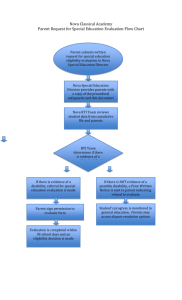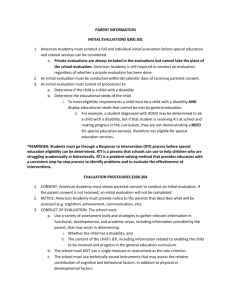SLD Training - Big East Educational Cooperative
advertisement
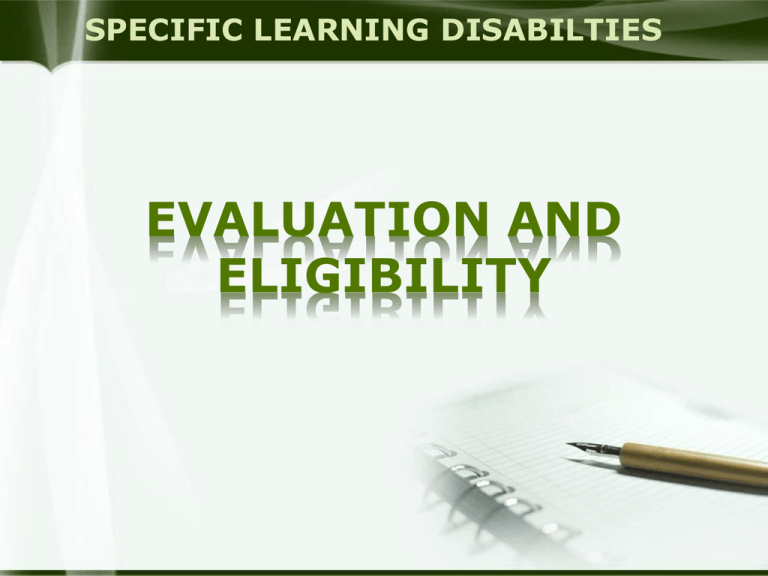
SPECIFIC LEARNING DISABILTIES EVALUATION AND ELIGIBILITY A child with a disability means… A child evaluated in accordance with 707 KAR 1:1300, as meeting the criteria listed in the definitions in this section for autism, deaf-blindness, developmental delay, emotionalbehavior disability, hearing impairment, mental disability, multiple disabilities, orthopedic impairment, other health impairment, specific learning disability, speech or language impairment, traumatic brain injury, or visual impairment which has an adverse effect on the child’s educational performance and who, as a result, needs special education and related services. 707 KAR 1:280§1(11) Definition Specific Learning Disability means a disorder that adversely affects the ability to acquire, comprehend or apply reading, mathematical, writing, reasoning, listening, or speaking skills to the extent that specially designed instruction is required to benefit from education. 707 KAR 1:002§1(59) SPECIFIC LEARNING DISABILITY May include dyslexia, dyscalculia, dysgraphia, developmental aphasia, and perceptual/motor disabilities. EXCLUDES: The term does not include deficits that are the result of other primary determinant or disabling factors such as vision, hearing, motor impairment, mental disability, emotionalbehavioral disability, environmental or economic disadvantaged, cultural factors or limited English proficiency or lack of research-based instruction in the deficit area. PROCEDURES AND CRITERIA FOR DETERMINING SPECIFIC LEARNING DISABILITY RESPONSE TO INTERVENTION (RtI) MODEL SEVERE DISCREPANCY MODEL Current Issues and Concerns The prevalence rate for SLD in KY is 2.2 percent. This is the lowest rate in the nation KDE priorities Ensure that the identification process identifies all truly disabled students Ensure that the identification process appropriately determines as ineligible students who have academic weaknesses for reasons other than a true disability Changes with IDEIA 04 Use of Response to Intervention allowed for eligibility determination States are no longer allowed to require districts to use a discrepancy model Analysis of Comments and Changes (p 46648) “an RtI process does not replace the need for a comprehensive evaluation. A public agency must use a variety of data gathering tools and strategies even if an RtI process is used.” THE RtI Model to Determine Eligibility The district must have: A research based model of Response to Intervention in place. Policies and procedures for implementation of a tiered model Evidence RtI was implemented with fidelity. The use of RtI for SLD Eligibility: Benefits and Challenges Challenges: RtI requires school-wide, systemic changes incorporating the following: High quality, research-based classroom instruction delivered by highly qualified personnel. General education teachers assume an active role in assessment of students in the general education curriculum. The use of RtI for SLD Eligibility: Challenges cont’d School staff conducts universal screening of academics and behavior. Strong administrative leadership Time for planning and collaboration Does not readily allow for uniformity of diagnosis across schools, districts, and states Evaluation Using Severe Discrepancy Model SLD manual published in 1993 with extensive training Changes have occurred in the world of assessment: WISC IV—only the Full Scale Score or General Ability Index are considered robust enough to be a reliable measure of cognition Use of Severe Discrepancy in Eligibility Determination for Specific Learning Disability. The Discrepancy Model With regard to a traditional discrepancy model, learning disabilities (LD) are determined primarily through the administration of cognitive (intellectual) and academic (achievement) testing. LD identification and special education services can be provided when a severe discrepancy between IQ and achievement, in conjunction with underlying processing issues have been found. Each state derives its own formula for establishing when a discrepancy can be considered severe. Needed Areas of Evaluation 8 areas of achievement in which a child may be determined to have a specific learning disability: • • • • • • • • • Oral expression Listening comprehension Written expression Basic reading skills Reading fluency skills Reading comprehension Mathematics calculation Mathematics problem solving Other x RTI Next Step in the Process If the ARC has chosen to use the Response to Intervention Model, then all universal screenings, interventions and progress monitoring data should be gathered in the area of concern. If the ARC has chosen to use the Severe Discrepancy Model, then an achievement test in the area of concern, which would yield standardized scores must be administered. Also… Prior to, or as a part of the referral process, the child was provided appropriate instruction in regular education settings, including that the instruction was delivered by qualified personnel; and Data-based documentation of repeated assessments of achievement at reasonable intervals, reflecting formal assessment of student progress during instruction, which was provided to the child’s parent. 707 KAR 1:130§2(6)(a)(b) Next Step in the Evaluation Process Areas of concern documented here Other Evaluation Personnel Needed Occupational Therapist Physical Therapist Orientation and Mobility Specialist Audiologist Visual Specialist In addition…. Next Step… Conduct, as appropriate, individual diagnostic assessments in the areas of speech and language. Then….. Should be completed for all children in the 8th grade or age 14. Determining the Need for Assistive Technology Evaluation After reviewing the student folder, teacher and parent input, the ARC will decide if an evaluation of Assistive Technology or modifications to evaluation procedures are required. x To exclude that educational deficits are not a result of cultural factors, environmental or economic disadvantage, or limited English proficiency, the ARC will request behavior observations in the areas of concern, parental input, social developmental data and any other existing data necessary to rule out these factors. Remember… At least one (1) team member other than the child’s regular education teacher shall observe the child in the learning environment, including the regular classroom setting, to document academic performance and behavior in the area of difficulty. If the child is less than school age or is out of school, the observation shall take place in an environment appropriate for the child. 707 KAR 1:130§2(5) Who can provide evaluation components? Qualified Personnel Can provide educational assessment? Can provide cognitive assessment? Can provide communication assessment? Can provide medical assessment? Psychiatrist No Yes No Yes School Psychologist Yes Yes Yes No Pediatrician or family physician No No No Yes Neurologist No Usually, no No Yes Teacher No No No No Speech/ Language Pathologist Yes No Yes No Also, make sure to… Obtain Consent for Evaluation Document Actions on page 2, III. A (Suspected disability, and description of action, and reason for decision on conference summary) Review Conference Documents Obtain Signatures of ARC Members Give written notice of action and other meeting documentation to parents. Notice of Invitation The determination of whether a child suspected of having a specific learning disability must be made by the child’s parents, and a team of qualified professionals which must include: The child’s regular education teacher For a child less than school age-an individual qualified to teach a child of his age. A special education teacher LEA Representative At least one person qualified to conduct, interpret and apply critical analysis to diagnostic evaluations such as a school psychologist, speech/language pathologist or remedial reading teacher. The Next Step…ELIGIBILITY THE OVERVIEW The ARC reviews evaluation information. The ARC determines if the required components of the evaluation are available and complete in the necessary areas. The ARC concludes if multiple nondiscriminatory methods were used. The ARC compares evaluation data with eligibility criteria. Determination is made Evaluation Procedures Used Each evaluation procedure, test, record, or report used to make a determination if the child has a specific learning disability must be documented on page 1 of the conference summary notice and a description attached to the conference summary/action notice. IF AFTER REVIEW OF DOCUMENTATION, MARK “YES “ ON #1. Next Step…designating areas of concern. The ARC will, based on earlier data, determine the areas of academic concern for the student. x x The Chosen Method: RTI The ARC… Must use district policies and procedures to determine eligibility. Evaluates all data and assessments according to district policies and procedures. Determines if model has been implemented with fidelity.. Step 3: RTI If the chosen method was RTI, and the child had failed to achieve a sufficient rate of learning, then mark Yes and put an X in the first box. The Chosen Method: Severe Discrepancy. If the ARC previously determined that the severe discrepancy model will be used for determination of eligibility, then: Must have state approved evaluator at meeting to explain data and provide analysis. Depending upon needed evaluation, analysis may be provided by a School Psychologist, Educational Specialist, Remedial Reading Teacher, or other designee depending upon area(s) of concern. Severe Discrepancy • Calculate the aptitude or ability test standard score • Calculate the student’s achievement test standard scores • Using the LD tables on KDE’s web page, identify the appropriate table of criterion discrepancy values for the particular aptitude-achievement discrepancy • Determine if a severe discrepancy exists LD REFERENCE TABLES Is the combination of measures used to evaluate ability and evaluate achievement included in the LD reference tables. LD REFERENCE TABLES Note regarding Regression True Score Method • When the SLD manual was released in 1993, there was no room for professional judgment when the aptitude-achievement discrepancy was not met • At this time, KDE is granting districts the option of using professional judgment If other data supports this decision. Other data could include – RtI data – Evidence of significant “soft signs” of a learning disability – The ARC should be able to clearly articulate the reasons for this decision and those reasons should be documented on the conference summary Non Standard Score Method • Provide a written rationale of why the formal evaluation procedures used with most students were invalid • List the formal and informal assessment procedures used to evidence the ability and/or achievement score • Provides scores and their interpretation from the alternative procedures • Form an aptitude-achievement discrepancy • Describe the expected performance of a typical age mate on each procedure • Evaluate the severity of the discrepancy. Common Reasons for Utilizing a Nonstandard Score Method • Tests not tabled – Common with Written Expression, Listening Comprehension, Oral Expression • Standardized achievement tests are generally not valid measures of achievement for young children (primary age for example) – There is insufficient floor in many of the achievement tests for young children – Tests designed for younger children are generally not tabled Further information on the use of both the Regression Estimated True Score method and the Non Standard Score method can be found in the manual on Kentucky Procedures and Criteria for Determining Specific Learning Disabilities SEVERE DISCREPANCY If the ARC chose to use the severe discrepancy method for evaluation and eligibility and the student exhibits a pattern of strengths and weaknesses in performance, achievement, or both relative to ability level or intellectual development. Step 3: Severe Discrepancy If a severe discrepancy exists, mark yes and put an X in the bottom box. Step 4: EXCLUSIONS Before the ARC can make a determination of eligibility, they must have data to address… •Were exclusions considered? •Were screenings and evaluations planned for? SCREENING The ARC should have used screening information, teacher and of parental input, informal observations and other data to plan if formal evaluations were needed in vision, hearing and motor abilities. If evaluations were requested, results should be reviewed to assure problems with vision, hearing, or motor abilities are not the reason for deficits in achievement. MENTAL DISABILITY If the district chose to use RtI as part of the evaluation process, they may have discovered the student had both low achievement and also poor progress when provided with learning experiences and instruction appropriate for the student’s age and grade level standards. However, they now must rule out that low achievement and poor progress is not a result of a mental disability. MENTAL DISABILITY EXCLUSION Administer a test measuring ability or IQ. John McCook, states that you can administer the subtest of vocabulary, arithmetic, and matrix reasoning on the WISC-IV and if they fall below the 85%, you should administer the total battery, if above 85% you can rule out mental disability. EMOTIONAL BEHAVIORAL DISABILITY Social/developmental history Behavior Observations Adaptive Behavior Teacher Input Parental Information Psychological Assessment OTHER FACTORS Cultural Factors Environmental Factors Economic Disadvantage Limited English Proficiency Mark yes to number 4 if you can exclude all these factors as being the cause the child is not achieving commensurate with same age peers and grade level standards or making sufficient progress toward that achievement. Step 5: LACK OF INSTRUCTION THE ARC MUST ASSURE THAT UNDERACHIEVEMENT IN A CHILD SUSPECTED OF HAVING A LEARNING DISABILITY IS NOT DUE TO LACK OF ACHIEVEMENT IN READING AND MATH. Questions the ARC must answer…. Was the child provided with appropriate instruction prior to or as part of the referral process? Was instruction provided in a regular education setting by qualified personnel? AND, data-based documentation of repeated assessments of achievement at reasonable intervals, reflecting formal assessment of student progress during instruction, which was provided to the child’s parents If the ARC can confirm that lack of instruction is not the determinant factor, mark yes on number 5. Step 6: Limited English Proficiency If the ARC, determined LEP was not a factor, mark yes. Step 7: Determination of Adverse Affect Definition: the progress of the child is impeded by the disability to the extent that the educational performance is significantly and consistently below the level of similar age peers. 34 CFR 300.8 707 KAR 1:280 Section 1 (2) Eligibility Determination: Adverse Affect • Review all student assessment results • Compare student performance to peers • The ARC determines “Adverse Affect” when: If the ARC has confirmed an adverse affect, check yes on box number 7 on the eligibility form. Next Step…Behavior Note any behavior of the child which was observed during the evaluation process, if it is relevant to the area of concern. Describe how the behavior was or was not impacting the academic functioning of the child, in the area of concern. Step 9: Medical Findings Any relevant medical findings which impact academic functioning should be listed here. This includes behavioral observations as well as teacher and parental input. Step 10: Instructional Strategies Strategies and Student Centered data from the referral should be attached. Attach records of strategies implemented and progress monitoring in the area of concern. Step 12: Communication with Parents If the results of the instructional strategies were shared with the parents, check yes on #12. ANALYZE THE RESULTS The ARC will now compare and analyze the evaluation data to ascertain if the student has a specific learning disability THE FINAL STEP: ELIGIBILITY
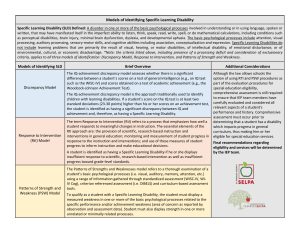
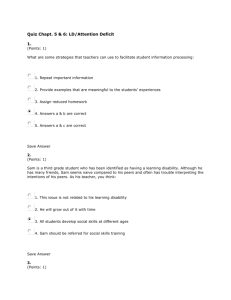
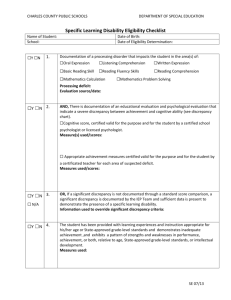
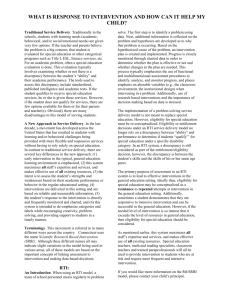
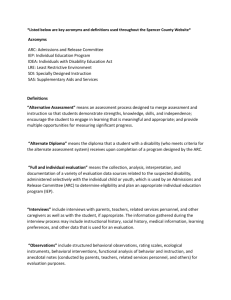
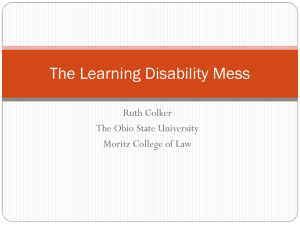
![SLD Eligibility Worksheet RtI/PSW [SELPA81]](http://s3.studylib.net/store/data/007788685_2-f357a545fa4de9948afc99b0c77416eb-300x300.png)
